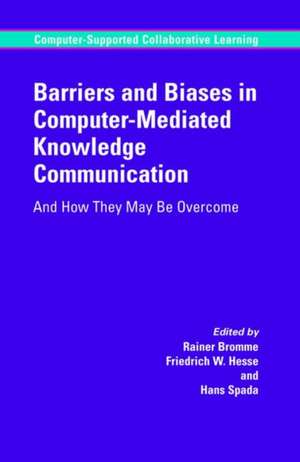Barriers and Biases in Computer-Mediated Knowledge Communication: And How They May Be Overcome: Computer-Supported Collaborative Learning Series, cartea 5
Editat de Rainer Bromme, Friedrich W. Hesse, Hans Spadaen Limba Engleză Hardback – 29 mar 2005
| Toate formatele și edițiile | Preț | Express |
|---|---|---|
| Paperback (1) | 946.87 lei 6-8 săpt. | |
| Springer Us – 6 dec 2010 | 946.87 lei 6-8 săpt. | |
| Hardback (1) | 953.20 lei 6-8 săpt. | |
| Springer Us – 29 mar 2005 | 953.20 lei 6-8 săpt. |
Din seria Computer-Supported Collaborative Learning Series
- 15%
 Preț: 659.53 lei
Preț: 659.53 lei - 15%
 Preț: 648.42 lei
Preț: 648.42 lei -
 Preț: 387.38 lei
Preț: 387.38 lei - 18%
 Preț: 1832.53 lei
Preț: 1832.53 lei - 18%
 Preț: 951.29 lei
Preț: 951.29 lei - 15%
 Preț: 642.83 lei
Preț: 642.83 lei - 18%
 Preț: 1135.35 lei
Preț: 1135.35 lei - 18%
 Preț: 949.55 lei
Preț: 949.55 lei - 18%
 Preț: 1021.68 lei
Preț: 1021.68 lei - 18%
 Preț: 1398.94 lei
Preț: 1398.94 lei - 18%
 Preț: 1241.25 lei
Preț: 1241.25 lei - 15%
 Preț: 639.73 lei
Preț: 639.73 lei - 15%
 Preț: 645.28 lei
Preț: 645.28 lei - 18%
 Preț: 955.25 lei
Preț: 955.25 lei - 18%
 Preț: 1116.09 lei
Preț: 1116.09 lei - 15%
 Preț: 646.11 lei
Preț: 646.11 lei - 15%
 Preț: 641.03 lei
Preț: 641.03 lei
Preț: 953.20 lei
Preț vechi: 1162.43 lei
-18% Nou
Puncte Express: 1430
Preț estimativ în valută:
182.39€ • 190.45$ • 150.61£
182.39€ • 190.45$ • 150.61£
Carte tipărită la comandă
Livrare economică 15-29 aprilie
Preluare comenzi: 021 569.72.76
Specificații
ISBN-13: 9780387243177
ISBN-10: 0387243178
Pagini: 334
Ilustrații: XII, 334 p.
Dimensiuni: 155 x 235 x 21 mm
Greutate: 0.67 kg
Ediția:2005
Editura: Springer Us
Colecția Springer
Seria Computer-Supported Collaborative Learning Series
Locul publicării:New York, NY, United States
ISBN-10: 0387243178
Pagini: 334
Ilustrații: XII, 334 p.
Dimensiuni: 155 x 235 x 21 mm
Greutate: 0.67 kg
Ediția:2005
Editura: Springer Us
Colecția Springer
Seria Computer-Supported Collaborative Learning Series
Locul publicării:New York, NY, United States
Public țintă
ResearchCuprins
Barriers, Biases and Opportunities of Communication and Cooperation with Computers: Introduction and Overview.- Facilitating Collaborative Knowledge Construction in Computer-Mediated Learning Environments with Cooperation Scripts.- How to Support Synchronous Net-Based Learning Discourses: Principles and Perspectives.- Instructional Support for Collaboration in Desktop Videoconference Settings.- Barriers and Biases in Computer-Mediated Expert-Layperson-Communication.- Exploring Why Virtual Teamworking is Effective in the Lab but More Difficult in the Workplace.- Social Dilemma in Knowledge Communication via Shared Databases.- Enhancing Sociability of Computer-Supported Collaborative Learning Environments.- Knowledge Sharing in Teams of Heterogeneous Experts.- Knowledge Communication in Design Communities.- Designing Biases That Augment Socio-Cognitive Interactions.- How Do People Learn?.- Technology Affordances for Intersubjective Learning, and How They May Be Exploited.
Textul de pe ultima copertă
This books deals with computer-mediated cooperation and communication scenarios in teaching and learning situations, leisure activities (e.g. laypersons looking for expert information on the internet), and net-based communication at work. Such scenarios will become increasingly important. But the successful use of such computer-mediated settings is not trivial. Cooperative learning and work itself requires special skills and strategies. And the technical settings with sometimes restricted, sometimes new possibilities for communication add problems on top of the cooperation itself. What are the barriers in computer-mediated communication for cooperative learning and work? Which are the most relevant biases in computer-mediated information processing? Based on empirical research the contributors from psychology, education and computer sciences offer different perspectives on the nature and causes of such barriers. The chapters also give an answer to the question how it might be possible to overcome these barriers and biases to fully gain advantage from the new technical opportunities. These results and answers are of interest for students as well as for researchers in all fields related to the use and evaluation of computer software in communication settings.
Caracteristici
Computer-mediated cooperation and communication scenarios become more and more important in teaching and learning situations, leisure activities, and net-based communication at work. Users often encounter several difficulties in such scenarios. What are the barriers in computer-mediated communication for cooperative learning and work? Which are the most relevant biases in computer-mediated information processing? Based on empirical research the chapters of this book offer different perspectives on the nature and causes of such barriers









